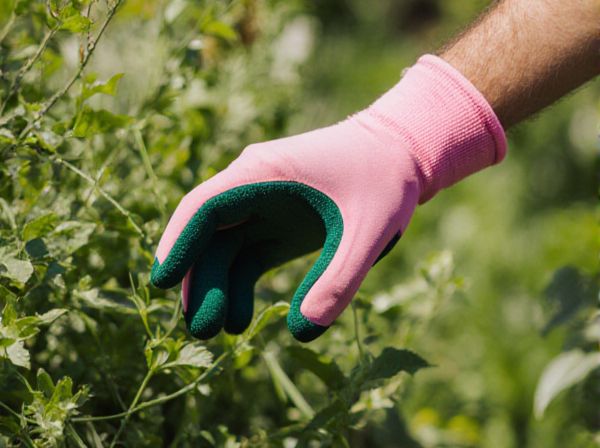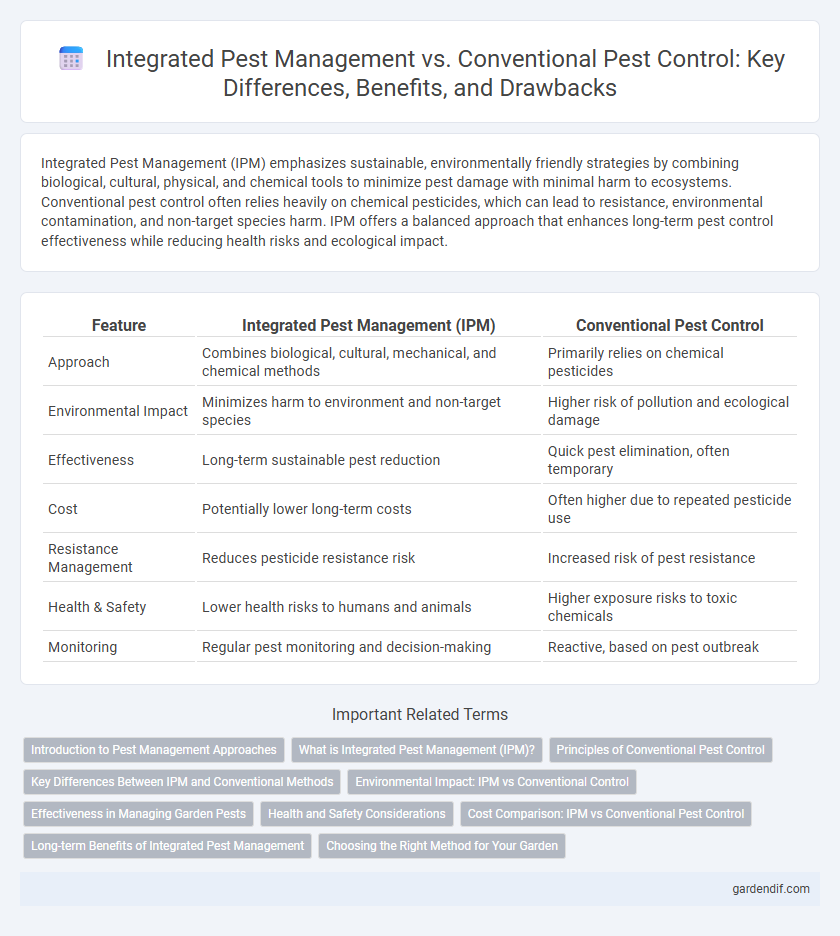
Integrated Pest Management vs Conventional Pest Control Illustration
Integrated Pest Management (IPM) emphasizes sustainable, environmentally friendly strategies by combining biological, cultural, physical, and chemical tools to minimize pest damage with minimal harm to ecosystems. Conventional pest control often relies heavily on chemical pesticides, which can lead to resistance, environmental contamination, and non-target species harm. IPM offers a balanced approach that enhances long-term pest control effectiveness while reducing health risks and ecological impact.
Table of Comparison
| Feature | Integrated Pest Management (IPM) | Conventional Pest Control |
|---|---|---|
| Approach | Combines biological, cultural, mechanical, and chemical methods | Primarily relies on chemical pesticides |
| Environmental Impact | Minimizes harm to environment and non-target species | Higher risk of pollution and ecological damage |
| Effectiveness | Long-term sustainable pest reduction | Quick pest elimination, often temporary |
| Cost | Potentially lower long-term costs | Often higher due to repeated pesticide use |
| Resistance Management | Reduces pesticide resistance risk | Increased risk of pest resistance |
| Health & Safety | Lower health risks to humans and animals | Higher exposure risks to toxic chemicals |
| Monitoring | Regular pest monitoring and decision-making | Reactive, based on pest outbreak |
Introduction to Pest Management Approaches
Integrated Pest Management (IPM) employs a combination of biological, cultural, mechanical, and chemical methods to control pest populations sustainably, emphasizing environmental safety and long-term prevention. Conventional pest control primarily relies on routine chemical pesticide applications, aiming for immediate and broad-spectrum pest elimination without considering ecological balance. IPM fosters ecological resilience by monitoring pest levels and using targeted interventions, reducing dependency on harmful chemicals compared to conventional practices.
What is Integrated Pest Management (IPM)?
Integrated Pest Management (IPM) is an environmentally sensitive approach that combines biological, cultural, mechanical, and chemical methods to manage pest populations effectively. IPM prioritizes long-term prevention and reduces reliance on chemical pesticides by promoting natural pest control mechanisms. This strategy enhances crop protection while minimizing risks to human health and the ecosystem.
Principles of Conventional Pest Control
Conventional pest control relies heavily on chemical pesticides to eliminate pests quickly and efficiently. It often emphasizes immediate pest eradication without extensive consideration of ecological balance or long-term sustainability. This approach prioritizes routine applications and high-cost treatments, which may lead to resistance development and environmental contamination.
Key Differences Between IPM and Conventional Methods
Integrated Pest Management (IPM) emphasizes sustainable pest control through a combination of biological, cultural, and mechanical methods, reducing reliance on chemical pesticides. Conventional pest control typically relies heavily on the frequent application of synthetic pesticides, which can lead to pesticide resistance and environmental harm. IPM prioritizes long-term prevention and ecosystem balance, whereas conventional methods focus on immediate pest eradication.
Environmental Impact: IPM vs Conventional Control
Integrated Pest Management (IPM) significantly reduces environmental impact by emphasizing biological controls, habitat manipulation, and the minimal use of chemical pesticides, leading to decreased pesticide residues in soil and water. Conventional pest control relies heavily on synthetic chemical applications, often resulting in pesticide runoff, non-target species harm, and increased resistance among pests. IPM promotes sustainable agriculture through ecosystem balance, preserving biodiversity and reducing ecological disruption compared to conventional methods.
Effectiveness in Managing Garden Pests
Integrated Pest Management (IPM) offers more sustainable and targeted effectiveness in managing garden pests by combining biological controls, cultural practices, and selective chemical use to minimize resistance and environmental impact. Conventional pest control often relies heavily on broad-spectrum pesticides, which may provide rapid but short-term pest reduction and can lead to pest resistance and non-target species harm. Gardens managed with IPM experience fewer pest outbreaks over time and maintain healthier ecosystems compared to those relying solely on conventional methods.
Health and Safety Considerations
Integrated Pest Management (IPM) emphasizes minimal chemical use, reducing health risks to humans and pets by employing biological controls, habitat manipulation, and targeted treatments. Conventional pest control often relies on broad-spectrum pesticides, increasing exposure to toxic substances and the potential for adverse health effects such as respiratory issues and skin irritation. IPM's strategic approach not only enhances safety but also mitigates environmental contamination and pesticide resistance.
Cost Comparison: IPM vs Conventional Pest Control
Integrated Pest Management (IPM) usually involves higher upfront costs due to comprehensive monitoring, biological controls, and preventive measures, whereas conventional pest control typically has lower initial expenses focused on chemical treatments. Over time, IPM reduces overall costs by minimizing pesticide use, preventing pest resistance, and promoting long-term pest suppression, leading to fewer repeat applications and damage control costs. Conventional pest control may incur recurring expenses from frequent pesticide applications and potential environmental remediation, making IPM a cost-effective solution in sustainable pest management strategies.
Long-term Benefits of Integrated Pest Management
Integrated Pest Management (IPM) offers sustainable, long-term benefits by reducing reliance on chemical pesticides, thereby minimizing environmental contamination and promoting biodiversity. IPM utilizes biological control agents, crop rotation, and habitat manipulation to create resilient agroecosystems that prevent pest outbreaks more effectively than conventional pest control methods. This strategic approach ultimately decreases pesticide resistance and enhances crop health, leading to improved yields and economic savings for farmers.
Choosing the Right Method for Your Garden
Integrated Pest Management (IPM) offers a sustainable approach by combining biological, cultural, and mechanical controls with minimal chemical use to protect garden health and biodiversity. Conventional pest control relies heavily on synthetic pesticides, providing quick pest elimination but posing risks to beneficial insects, soil quality, and potential chemical resistance. Selecting the right method involves assessing pest severity, garden ecosystem, and long-term environmental impact to achieve effective, eco-friendly pest management.
Integrated Pest Management vs Conventional Pest Control Infographic

 gardendif.com
gardendif.com